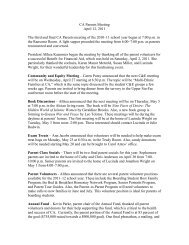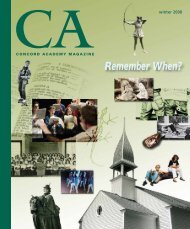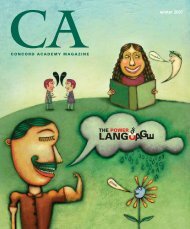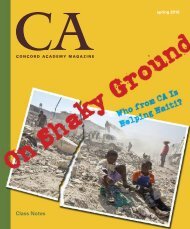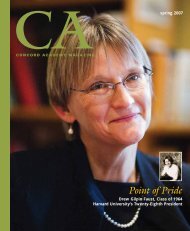CAMPUS
Meet Rick Hardy - Concord Academy
Meet Rick Hardy - Concord Academy
You also want an ePaper? Increase the reach of your titles
YUMPU automatically turns print PDFs into web optimized ePapers that Google loves.
Starbucks or Street Senseby Claire Wright ’11We have all been there. You’rewalking down the street in,let’s say, Boston. Juggling a coffee inone hand while holding several shoppingbags in the other. You are thinkingabout the errands you need tocomplete while trying to figure outwho you forgot to call. Then suddenly,someone approaches asking formoney. In less than ten seconds, youhave to decide whether or not to givemoney, and if yes, how much?What makes you feel the need togive—guilt, necessity, compassion?Most of us deal with these questionsalmost every day, but in Washingtonwe were on the other side. Tobe the person everyone tries not tolook at, tries to avoid. We were thepeople asking for money—and it washard.Street Sense is a newspaper wherethe homeless can “give and earn theirtwo cents.” As part of our volunteerwork, we had the chance to sell thepapers and, under the supervision of amentor (a homeless vendor), weheaded to a Chinatown corner to startselling. With ten papers in hand, aneon yellow vest, and several statistics,we began our work. I had never beenso scared—we had to walk up to peopleand ask for their money. Whilementally freaking out, I approachedseveral men dressed in nice businesssuits and carrying briefcases. As I anxiouslyrecited the statistics, silentlypleading for them to buy the paper,they held their hands up and walkedthe other way. OK, I can deal withthis, I thought, and I stepped into thecenter of the block and began again.For two hours I approached people,using the opening line, “Did youknow that there are 3.5 million homelessin America and over 30,000 inDC? Do you have time to show youcare?” Some people immediatelypulled out their wallets and gave,smiling and saying how much theyappreciated our work. One manwalked right through, pushing me outof the way with his hand. Somelaughed, and some didn’t even meetmy eye. Others stopped to talk.There were moments when I wasshocked at how horrible people couldbe, and how bad people were at lying.It wasn’t that people didn’t feel compelledto give that bothered me, butrather that people could look me inthe eye while holding wads of cashand tell me they didn’t have money onthem. Another eye-opener was theStarbucks cups. Now, I have to admitthat I like my nonfat half-shot caramelmacchiato, and I usually don’t thinktwice about handing over $3.95 topay for it. But standing on the streetcorner, I realized that giving up thatdrink one day a week could givesomeone a meal, a shower, anotherstep toward a second chance.I’m not saying that peopleshould give money every time they areasked. That can be careless. And sometimesit isn’t even the money that matters.After being laughed at, ignored,and glared at, even a smile felt like astep forward. Money was great; I feltan overwhelming excitement whenpeople pulled out their wallets. Butnext time I walk down the street andsomeone asks me to give money, Iknow that I will smile, say “hi,” andmaybe think twice about my nonfathalf-shot caramel macchiato.Where the Heart Isby Olivia Pimm ’10We awoke Monday morningready to receive our workassignments. The three leaders ofthe Youth Services OpportunitiesProject (YSOP) asked us to completethe following statement: “Thelast time I saw a homeless person, Ifelt . . .” Among our responses were“helpless,” “guilty,” and “uncomfortable.”Following the exercise, ourgroup leader explained that guilt isultimately useless in the fight to endhomelessness. Later that day, aspeaker from the National Coalitionfor the Homeless spoke of stereotypes:Contrary to our naïveassumptions, not all homeless personsare lazy, jobless, or addicts. Infact, the speaker himself was homelessat the time, due to an accident.It would have never crossed ourminds that this man was homeless,based on his well-groomed appearanceand his ability to relate to theaudience. To conclude his movingspeech, he asked us to acknowledgethe next homeless person weencounter and offer them a simpleand sincere “hello.” He claimed thatany attention he received from peoplepassing by helped him endurethe next hour or so on the streets.Taking the speaker’s words toheart, students kindly greeted eachhomeless person on the streets ofGeorgetown on their way to dinnerlater that night. Indeed, that Mondayhad prepared us for an excitingand humbling week of service in thecapital. Students and staff workedfor a number of different organizations,including Martha’s Table,which provides food, clothing, anddaycare; a local charter school;Street Sense, a newspaper writtenand published by the city’s homelessand formerly homeless; and theCapital Area Food Bank. Work consistedprimarily of babysitting forlow-income families, sorting andpackaging clothing and food, painting,or yard work.CA students and staff agreedthat a service dinner was the highlightof the trip. On Wednesdaynight, following our day’s work,students carefully prepared a mealfor nearly fifty homeless or hungrymembers of the DC community.Later, we sat and ate alongside ourguests, exchanging jokes and stories.To our surprise, conversationflowed naturally, despite our separatelifestyles. The guests openlyoffered students advice—to listen toour parents, stay in school, and setgoals for ourselves. Students listenedattentively, admiring theguests’ wisdom. At the event, I meta young boy named Gabriel, theson of a guest. Like any toddler,Gabriel enjoyed chatting and coloring.I realized that, despite his family’sdifficult situation, Gabrielmaintains his childhood innocence.And I suppose that is how it shouldbe. As the dinner came to a close,each of the guests expressed appreciationfor the volunteers’ time andattention. We too were thankful forthe opportunity to share a mealwith these unique individuals andtheir families.To conclude the week, thegroup revisited the prompt fromthe first day: “The last time I saw ahomeless person I felt . . .” Ourresponses revealed our changed attitudes.Together, we shed our initialdiscomfort and apprehension. Inreality, CA students and the homelesscommunity share similar interests,political beliefs, and sometimeseven childhood upbringings. Mypeers and I returned to our homeswith an entirely new outlook: likeCA community members and theirfamilies, homeless people worldwideare human beings who ultimatelyrequire care, compassion,and, at times, a helping hand.9W W W . C O N C O R D A C A D E M Y. O R G F A L L 2 0 0 9




